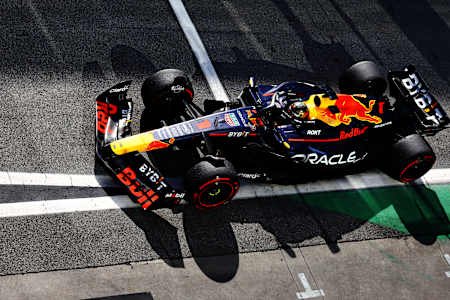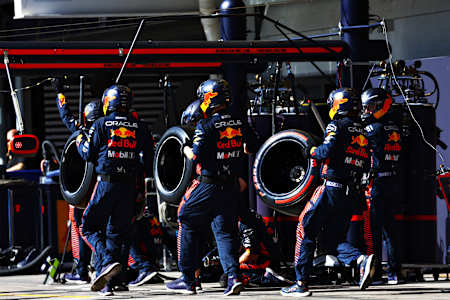Red Bull Motorsports
Formula 1 is an exhilarating, internationally-recognized motorsport involving triple-digit speeds. This means, of course, that what happens behind the steering wheel is undoubtedly important for winning an F1 race. But just as important to winning are the actual wheels, the rubber on the road.
Max Verstappen during the F1 Grand Prix of Brazil 2023 in Sao Paulo
© Getty Images / Red Bull Content Pool
Formula 1 tire strategy plays a huge role in winning that F1 trophy, and the most important factor is a tire’s compound. Read ahead for an F1 tire compound guide covering how compounds affect performance and how F1 tire technology is changing.
01
What are F1 tire compounds?
F1 tire compounds are the materials used for Formula 1 race car tires. F1 constructors strive for a certain level of softness or hardness in the rubber blends that line their car’s wheels. Hard tires are more durable, while softer tires are better for speed. Tire compound elasticity will have a significant impact on overall performance, but it’s not necessarily a one-size-fits-all scenario. For instance, certain F1 tire types work great in dry weather.
During an F1 event, teams are given 20 total sets of tires made from a range of compounds. Tire compound regulations in Formula 1 dictate that all drivers must use a minimum of two compound types per race in dry weather. The one exception is for inclement weather — F1 drivers don’t have to worry about tire grip issues if it’s raining during a race.
02
Types of F1 tire compounds
When F1 teams are issued sets of tires for each race, they include 13 dry-weather, or “slick” tires, four intermediate, and three wet sets. These three tire types are meant for use in the corresponding climate and road conditions.
Dry tires are smooth without any grooves, and they’re used when there’s no precipitation. Wet tires, sometimes called “full wet” tires, are for when it’s especially rainy. Intermediate tires are for light rain when the road is slightly slick. Both of the latter types are covered in grooves and patterns that make it easier to drive on a wet road.
Each of these classifications within a team’s F1 tire compound selection is color-coded to denote category and flexibility. Dry tires are red (soft), white (hard), and yellow (medium), while intermediate tires are green and wet tires are blue.
Additionally, with dry sets, the tire compound naming convention specifies the exact level of pliability, ranging from hardest (C1 tires) to softest (C5 tires). A team might prefer one of these five tire compound characteristics over another depending on their racing conditions.
Red Bull Racing team prepare for a pitstop at the F1 Grand Prix of Brazil
© Getty Images / Red Bull Content Pool
- C1: As the most durable dry tire compound, this classification is best for longer races.
- C2: The second-hardest tire compound is great for high heats and newer F1 tracks for which tire wear isn’t yet established.
- C3: If you need a dry tire exactly in the middle, C3s offer a great balance.
- C4: A C4 tire can provide optimal performance on tight, high-speed turns.
- C5: This type of dry tire is the fastest you can get.
Selecting the right tire compound
Since an F1 weekend features multiple races, teams have to be incredibly strategic about when and where to use each tire compound. To add another layer of complexity, drivers are also required to return two sets of tires after each of an F1 event’s three practice runs. A team that did great at practice can’t use the same high-performing tire set during the actual race or the qualifying round.
F1 teams take all of this into account when deciding which tires to use each time they hit the circuit. Practice runs are important for testing out compound types on a track, even if F1 teams must turn in these tires at the end. Through these practice runs, teams learn all the intricacies of a course, from how tight the turns are to the road’s grip.
F1 teams also try to prepare ahead based on the weather forecast. Hot weather usually means tires degrade faster, requiring multiple tire changes. F1 tire compound strategy is a delicate balance of careful planning and fortunate timing and conditions.
03
Tire compound changes during a race
Max Verstappen makes a pitstop during the 2023 F1 Grand Prix of Qatar
© Getty Images / Red Bull Content Pool
Since drivers are required to use at least two compounds during a dry race, tire strategy during pit stops can change everything in an instant. Let’s say a team starts with a harder tire for a longer circuit. At some point, they’ll have to change to a softer compound. This change could give them an advantage if they need a little extra speed to get ahead as the finish line approaches. But if they’re on a track with subpar grip, that soft tire could give out sooner, requiring extra pit stops and slowing them down.
If you’ve ever watched a Formula 1 tire change, you know they happen at lightning speed. This means mistakes can also happen just as quickly, so teams need to be extra careful about sticking to regulations. For instance, if a pit crew makes a mistake during a stop, either by mismatching a set of tires or using a non-allocated set, that error could result in a penalty that costs their team the entire race.
04
The past and future of F1 tire compounds
F1 tire compound development and innovation has influenced the sport throughout its history, including exciting breakthroughs and some significant upsets.
F1 tire compound history
Early F1 tires were made of the same rubber as the standard automobile. That changed as competition in the World Championships got more fierce with each passing year. The rules on tire compounds have fluctuated quite a bit through the years in an effort to balance safety, fairness, and speed.
For example, dry tires without grooves weren’t introduced to the sport until the 1970s. After three decades of slick tires, the groove requirement was reintroduced in 1998 to counteract the intense speeds, but that only lasted until 2008.
The FIA, Formula 1’s top governing body, also prohibited tire changes in 2005 in an attempt to even the playing field. However, at that year’s U.S. Grand Prix, the new rule resulted in one of the biggest tire compound controversies in F1 history. At the time, Formula 1 had contracts with two tire suppliers, Michelin and Bridgestone. During practice, one of the tires for Ralf Schumacher, a driver on one of the Michelin teams, failed.
After reviewing all of their tire sets for the weekend, Michelin realized they couldn’t confirm tire safety for an entire race. Following several rounds of back-and-forth meetings between Michelin and the FIA organizers, neither side was able to reach a solution. The Michelin drivers only participated in the initial formation lap during the final race, and the weekend ended on an extremely sour note.
The future of F1 tire compounds
Max Verstappen during the 2023 F1 Grand Prix of Brazil in Sao Paulo
© Getty Images / Red Bull Content Pool
There is currently only one tire supplier contracted with Formula 1: Italian manufacturer Pirelli. This manufacturer’s contract is set to end in 2027, but whether F1 renews or not, Pirelli is operating with a future-oriented mindset. With sustainable tire manufacturing in F1 a high priority, Pirelli is working on developing compounds that don’t need to be pre-heated. This pending Formula 1 tire technology advancement would significantly reduce F1’s electrical needs and carbon footprint.
Since regulations are always in flux, the FIA has also decided to experiment with new requirements at select events in the 2023 season. Each qualifying round will permit only one type of compound, with hard tires in the first session, medium in the second, and soft in the third. The total number of dry tires will also be reduced from 13 to 11.
Tire compounds can make or break a race
Tire compound impact on race performance has been pivotal throughout the decades of Formula 1. Choosing the right or wrong compound can truly be the difference between victory and defeat. Currently, the future of tire compounds in Formula 1 may be unwritten, but one thing is for sure. Tire materials will always play a central role in the sport’s next evolution.











